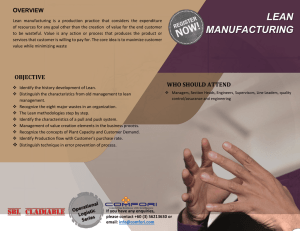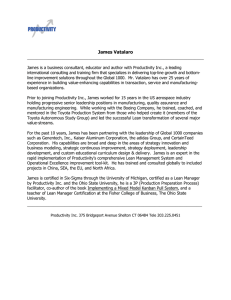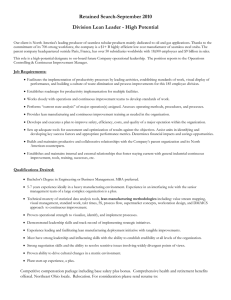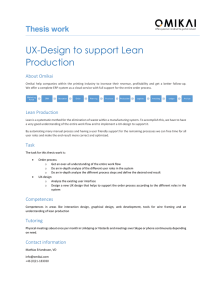Research Journal of Applied Sciences, Engineering and Technology 7(13): 2680-2686,... ISSN: 2040-7459; e-ISSN: 2040-7467
advertisement
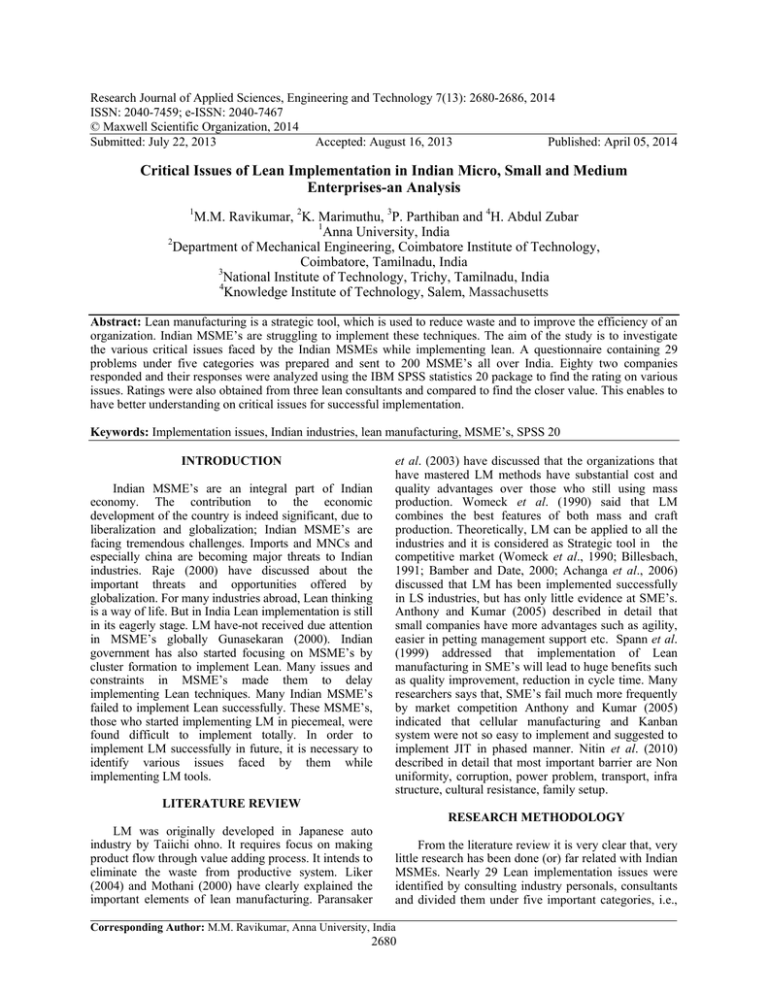
Research Journal of Applied Sciences, Engineering and Technology 7(13): 2680-2686, 2014 ISSN: 2040-7459; e-ISSN: 2040-7467 © Maxwell Scientific Organization, 2014 Submitted: July 22, 2013 Accepted: August 16, 2013 Published: April 05, 2014 Critical Issues of Lean Implementation in Indian Micro, Small and Medium Enterprises-an Analysis 1 M.M. Ravikumar, 2K. Marimuthu, 3P. Parthiban and 4H. Abdul Zubar 1 Anna University, India 2 Department of Mechanical Engineering, Coimbatore Institute of Technology, Coimbatore, Tamilnadu, India 3 National Institute of Technology, Trichy, Tamilnadu, India 4 Knowledge Institute of Technology, Salem, Massachusetts Abstract: Lean manufacturing is a strategic tool, which is used to reduce waste and to improve the efficiency of an organization. Indian MSME’s are struggling to implement these techniques. The aim of the study is to investigate the various critical issues faced by the Indian MSMEs while implementing lean. A questionnaire containing 29 problems under five categories was prepared and sent to 200 MSME’s all over India. Eighty two companies responded and their responses were analyzed using the IBM SPSS statistics 20 package to find the rating on various issues. Ratings were also obtained from three lean consultants and compared to find the closer value. This enables to have better understanding on critical issues for successful implementation. Keywords: Implementation issues, Indian industries, lean manufacturing, MSME’s, SPSS 20 INTRODUCTION Indian MSME’s are an integral part of Indian economy. The contribution to the economic development of the country is indeed significant, due to liberalization and globalization; Indian MSME’s are facing tremendous challenges. Imports and MNCs and especially china are becoming major threats to Indian industries. Raje (2000) have discussed about the important threats and opportunities offered by globalization. For many industries abroad, Lean thinking is a way of life. But in India Lean implementation is still in its eagerly stage. LM have-not received due attention in MSME’s globally Gunasekaran (2000). Indian government has also started focusing on MSME’s by cluster formation to implement Lean. Many issues and constraints in MSME’s made them to delay implementing Lean techniques. Many Indian MSME’s failed to implement Lean successfully. These MSME’s, those who started implementing LM in piecemeal, were found difficult to implement totally. In order to implement LM successfully in future, it is necessary to identify various issues faced by them while implementing LM tools. et al. (2003) have discussed that the organizations that have mastered LM methods have substantial cost and quality advantages over those who still using mass production. Womeck et al. (1990) said that LM combines the best features of both mass and craft production. Theoretically, LM can be applied to all the industries and it is considered as Strategic tool in the competitive market (Womeck et al., 1990; Billesbach, 1991; Bamber and Date, 2000; Achanga et al., 2006) discussed that LM has been implemented successfully in LS industries, but has only little evidence at SME’s. Anthony and Kumar (2005) described in detail that small companies have more advantages such as agility, easier in petting management support etc. Spann et al. (1999) addressed that implementation of Lean manufacturing in SME’s will lead to huge benefits such as quality improvement, reduction in cycle time. Many researchers says that, SME’s fail much more frequently by market competition Anthony and Kumar (2005) indicated that cellular manufacturing and Kanban system were not so easy to implement and suggested to implement JIT in phased manner. Nitin et al. (2010) described in detail that most important barrier are Non uniformity, corruption, power problem, transport, infra structure, cultural resistance, family setup. LITERATURE REVIEW RESEARCH METHODOLOGY LM was originally developed in Japanese auto industry by Taiichi ohno. It requires focus on making product flow through value adding process. It intends to eliminate the waste from productive system. Liker (2004) and Mothani (2000) have clearly explained the important elements of lean manufacturing. Paransaker From the literature review it is very clear that, very little research has been done (or) far related with Indian MSMEs. Nearly 29 Lean implementation issues were identified by consulting industry personals, consultants and divided them under five important categories, i.e., Corresponding Author: M.M. Ravikumar, Anna University, India 2680 Res. J. App. Sci. Eng. Technol., 7(13): 2680-2686, 2014 problems related with Employees, Management, Supplier, Customer and organization. Further these issues were analyzed and rated to find their importance by using latest IBM SPSS statistics 20 package tools. Three Lean consultants were used to give their expert opinion and compared with their ranking. RESULTS AND DISCUSSION A questionnaire was prepared after identifying 29 problems of lean implementation with discussion to industrial personals, consultants and sent to 200 Indian MSME’s. The responses of 82 industries were received on a four-point scale ranging from low to very high. Later 29 lean issues in reduced in to five broad categories, i.e., customer’s issues, organizational issues, supplier issues, employee issues and management issues. Further descriptive statistics was used to find the importance of lean issues to Indian industry by using the latest IBM SPSS statistics 20 package which has the recent statistical tools. First we have organized our data in the form of cross tabulation to find out the major issues from the above five issues (customers issues, organizational issues, supplier issues, employee issues and management issues) which are given in the Table 1 and 2. The measures of central tendency gives the main idea (central part) of the data and the measures of dispersion gives the complete idea of the data. Hence, next we focus on the report with the major central tendency, called mean, median, measures of dispersion, called standard deviation, variance and range. Moreover, the skewness and kurtosis are also obtained so that we can observe the main idea (Centre Table 1: Cross tabulation between issues and rating Rating -----------------------------------------------------------------------------------------------------------------------Issues Low Medium High Very high Organizational issues 10 116 373 75 Management issues 114 366 12 0 Customer issues 0 191 137 0 Supplier issues 8 112 284 6 Employee issues 81 442 51 0 Total 213 1227 857 81 Table 2: Cross tabulation between lean implementation issues and rating Rating -----------------------------------------------------------------------------------------Low Medium High Very high Lean implementation issues High inventory 0 0 73 9 High rejection rate 2 12 66 2 Employee absenteeism 6 10 66 0 High contract labors 0 81 1 0 High set up time/high change over time 2 13 65 2 Lack of practical implementation knowledge within the 0 0 65 17 company Lack of knowledge about the existing specialists 0 0 37 45 Frequent break downs 10 72 0 0 Lack of funds 3 78 1 0 Skilled man power 0 72 10 0 Lack of support from top management 7 74 1 0 Quality consciousness 22 60 0 0 Owner cum managers 72 10 0 0 High response time 0 2 80 0 To reduce rejection rate 0 62 20 0 To reduce cost 0 46 36 0 To reduce delivery time 0 81 1 0 Poor communication 0 2 76 4 High lead time 2 13 65 2 Unreliable transport 6 10 66 0 High competitions 0 6 76 0 Frequent changes in supply 0 81 1 0 Lack of job security 0 65 17 0 Poor salary and wages 15 67 0 0 High customer pressure 7 73 2 0 Lack of knowledge 0 62 20 0 To reduce misunderstanding (we can purchase) 0 70 12 0 To reduce bought out products 26 56 0 0 To reduce gap between requirement (vs.) availability of 33 49 0 0 manpower Total 213 1227 857 81 2681 Total 574 492 328 410 574 2378 Total 82 82 82 82 82 82 82 82 82 82 82 82 82 82 82 82 82 82 82 82 82 82 82 82 82 82 82 82 82 2378 Res. J. App. Sci. Eng. Technol., 7(13): 2680-2686, 2014 Table 3: Report (descriptive analysis) Issues N Mean Median Organizational issues 574 3.8937 4.0000 Management issues 492 2.7927 3.0000 Customer issues 328 3.4177 3.0000 Supplier issues 410 3.7024 4.0000 Employee issues 574 2.9477 3.0000 Total 2378 3.3389 3.0000 S.D.: Standard deviation; S.E.M.: Standard error of mean S.D. 0.62596 0.46212 0.49393 0.52725 0.47711 0.68668 S.E.M. 0.02613 0.02083 0.02727 0.02604 0.01991 0.01408 Range 3.00 2.00 1.00 3.00 2.00 3.00 Variance 0.392 0.214 0.244 0.278 0.228 0.472 Skewness -348 -671 0.335 -967 -153 0.078 Kurtosis 0.603 0.200 -1.899 0.628 1.337 -0.194 Table 4: Report (descriptive analysis) Median 4 4 4 3 4 S.D. 0.31451 0.49203 0.58897 0.11043 0.50008 S.E.M. 0.03473 0.05434 0.06504 0.01220 0.05522 Range 1.00 3.00 2.00 1.00 3.00 Variance 0.099 0.242 0.347 0.012 0.250 4 0.40788 0.04504 1.00 0.166 1.471 0.167 5 0.50068 0.05529 1.00 0.251 -0.200 -2.010 3 3 3 3 0.32924 0.22086 0.32924 0.30552 0.03636 0.02439 0.03636 0.03374 1.00 2.00 1.00 2.00 0.108 0.049 0.108 0.093 -2.354 -2.008 2.354 -1.912 3.629 18.224 3.629 6.794 3 2 4 3 3 3 4 4 4 4 3 3 3 3 3 3 0.44580 0.32924 0.15521 0.43208 0.49932 0.11043 0.27106 0.50008 0.58897 0.26202 0.11043 0.40788 0.38899 0.32764 0.43208 0.35562 0.04923 0.03636 0.01714 0.04771 0.05514 0.01220 0.02993 0.05522 0.06504 0.02894 0.01220 0.04504 0.04296 0.03618 0.04771 0.03927 1.00 1.00 1.00 1.00 1.00 1.00 2.00 3.00 2.00 1.00 1.00 1.00 1.00 2.00 1.00 1.00 0.199 0.108 0.024 0.187 0.249 0.012 0.073 0.250 0.347 0.069 0.012 0.166 0.151 0.107 0.187 0.126 -1.066 2.354 -6.282 1.215 0.250 9.055 0.993 -1.556 -2.094 -3.339 9.055 1.471 -1.671 -1.220 1.215 2.039 -0.887 3.629 38.399 -0.537 -1.986 82.000 11.235 3.601 3.202 9.380 82.000 0.167 0.811 6.090 -0.537 2.209 3 3 0.46820 0.49341 0.05170 0.05449 1.00 1.00 0.219 0.243 -0.801 -0.405 -1.393 -1.882 3 0.68668 0.01408 3.00 0.472 0.078 -0.194 Skewness Kurtosis 2.544 4.581 -1.652 4.118 -2.094 3.202 9.055 82.000 -1.556 3.601 4.00 3.80 3.60 3.40 3.20 3.00 Fig. 1: Mean rating of issues 2682 Issues Em p iss loyee ues Su p is s p lie r ues Cu st iss omer u es Ma nag iss eme ues nt 2.80 Or g an i iss zatio ues nal part) and the complete idea of our data. The Table 3 and 4 gives such reports (descriptive analysis). Now, one can observe that the organizational issues have the highest average and standard deviation whereas the management issues have minimum aggregate with mean and standard deviation. Moreover, the skewness represents the lack of symmetry which indicates whether the frequency curve is turned more to one side than to the other. If the data is symmetric, then the skewness is zero. But, here except the customer issue, the remaining are all negatively skewed and hence the mode (maximum frequency) is greater than their average for them. The kurutosis represents the flatness of the frequency curve and depends on the number of items Mean of rating Lean implementation issues N Mean High inventory 82 4.1098 High rejection rate 82 3.8293 Employee absenteeism 82 3.7317 High contract labors 82 3.0122 High set up time/high change over 82 3.8171 time Lack of practical implementation 82 4.2073 knowledge within the company Lack of knowledge about the 82 4.5488 existing specialists Frequent break downs 82 2.8780 Lack of funds 82 2.9756 Skilled man power 82 3.1220 Lack of support from top 82 2.9268 management Quality consciousness 82 2.7317 Owner cum managers 82 2.1220 High response time 82 3.9756 To reduce rejection rate 82 3.2439 To reduce cost 82 3.4390 To reduce delivery time 82 3.0122 Poor communication 82 4.0244 High lead time 82 3.8171 Unreliable transport 82 3.7317 High competitions 82 3.9268 Frequent changes in supply 82 3.0122 Lack of job security 82 3.2073 Poor salary and wages 82 2.8171 High customer pressure 82 2.9390 Lack of knowledge 82 3.2439 To reduce misunderstanding (we 82 3.1463 can purchase) To reduce bought out products 82 2.6829 To reduce gap between 82 2.5976 requirement (vs.) availability of manpower Total 2378 3.3389 S.D.: Standard deviation; S.E.M.: Standard error of mean Res. J. App. Sci. Eng. Technol., 7(13): 2680-2686, 2014 5.00 Mean of rating 4.50 4.00 3.50 3.00 2.50 2.00 To reduce gap between requirement (Vs) Availability of manpower To reduce misunderstanding (we can purchase) High customer pressure Lack of job security High competitions High lead time To reduce delivery time To reduce rejection rate Owner cum managers Lack of support from top management Lack of funds Lack of knowledge about the existing specialists High set up time/high change over time Employment absenteeism High inventory Fig. 2: Mean rating of lean implementation issues Fig. 3: Bar Chart for ratings on issues near to the mode (maximum frequency) and it is denoted by β 2 . If β 2 = 3, then the frequency curve is moderately peaked or moderately flat and it is said to be mesokurtic. If β 2 <3, then the frequency curve is largely flat and it is said to be platykurtic. If β 2 >3, then the frequency curve is highly peaked and it is said to be leptokurtic. Also the excess of kurtosis is defined by γ 2 = β 2 - 3. Here, all the issues have the kurtosis less than 3 of which the kurtosis of management issue is very nearer to zero. The mean rating of the issues and lean implementation issues are represented in the frequency curves in Fig. 1 and 2. So that one can easily identify 2683 Res. J. App. Sci. Eng. Technol., 7(13): 2680-2686, 2014 Fig. 4: Bar chart for ratings on lean implementation issues 500 Count 400 issue plays the major role and the management issue has the less importance. Hence, The Issues and Lean implementation issues are highly positive correlated (same direction): Low Medium High Very high 300 • 200 • 100 Em p iss loyee ues Su p is s p lie r ues Cu st iss omer u es Ma nag iss eme ues nt Or g an i iss zatio ues nal 0 Issues Fig. 5: Bar chart for ratings on issues over the companies that the organizational issues are with top rated and the management issues are with low average. The bar charts are given for the number of frequencies of the different varieties of ratings for the issues and lean implementation issues in the Fig. 3 to 5, from which the ratings “high” and “very high” have the maximum points for organizational issues whereas it is very for management issues. So Organizational issues play the vital role in Indian markets and the management issues become the negligible one. Thus, it is observed that the lean issues play the roles in the following order: Organizational issues, Supplier issues, Customer issues, Employee issues, Management issues. It shows that the organizational The Issues and the ratings are negatively correlated (opposite direction). Lean implementation issues and the ratings are negatively correlated shown in Table 5 (opposite direction). The paired sample tests in Table 6 also show that there is significant difference between the below three pairs. In Table 7 and 8 ANOVA provides a statistical test of whether or not the means of several groups are equal and its sums of squares indicate the variance of each component of the decomposition. Comparisons of mean squares allow testing of a nested sequence of models. Chi square test: The sampling test is also the most important one in analysis of data. The chi square test can be used to test the uniformity of the distribution. Here, we used the chi square test to check whether the following five types of issues play the role uniformly in the Indian market or not (Table 9 to 11 and Fig. 6). Null hypothesis H 0 : The five types of issues play the role uniformly in the Indian market. Alternative hypothesis H 1 : The five types of issues do not play the role uniformly in the Indian market. 2684 Res. J. App. Sci. Eng. Technol., 7(13): 2680-2686, 2014 Table 5: Correlation co-efficient Karl Pearson’s coefficient of correlation ----------------------------------------------------------------------------Lean implementation Issues issues Ratings Issues 0.976 -0.269 Lean implementation -0.325 Issues Ratings - Spearman’s rank coefficient of correlation --------------------------------------------------------------Lean implementation Issues issues Ratings 0.978 -0.300 - - - - -0.329 - Table 6: Paired sample test Pairs Pair 1 Pair 2 Pair 3 Issues-rating Rating-lean implementation issues Lean implementation issues company Paired differences ---------------------------------------------------------------------------------95% confidence interval of the difference --------------------------------Mean S.D. S.E.M. Lower Upper -0.37342 1.82863 0.03750 -0.44696 0.29989 -11.66106 8.61627 0.17669 -12.00754 11.31458 -26.50000 25.11006 0.51492 -27.50974 25.49026 Table 7: ANOVA Issues S.S. d.f. M.S. F Sig. Between groups 549.830 3 183.277 88.053 0.000 Within groups 4941.342 2374 2.081 Total 5491.172 2377 S.S.: Sum of square; D.F.: Degree of freedom; M.S.: Mean of square Table 8: ANOVA Issues S.S. d.f. M.S. F Sig. Between groups 19953.884 3 6651.295 107.778 0.000 Within groups 146506.116 2374 61.713 Total 166460.000 2377 S.S.: Sum of square; D.F.: Degree of freedom; M.S.: Mean of square Table 9: Issues Issues Organizational issues Management issues Customer issues Supplier issues Employee issues Total Table 10: Rating Rate Low Medium High Very high Total Observed N 574 492 328 410 574 2378 Observed N 213 1227 857 81 2378 Test statistic t -9.958 -65.997 -51.464 Degrees of freedom 2377 2377 2377 Expected N 475.6 475.6 475.6 475.6 475.6 Residual 98.4 16.4 -147.6 -65.6 98.4 Expected N 594.5 594.5 594.5 594.5 Residual -381.5 632.5 262.5 -513.5 Table 11: Comparisons Issues 96.138 4 0.000 Fraction of nonconformities Chi-square Df Asymp. sig. 4.0 Rating 1477.186 3 0.000 Rating LCL UCL Sigma level: 3 Central = 3.3389 3.8 3.6 3.4 3.2 3.0 Em p iss loyee u es Su p is s p lie r ues Cu st iss omer u es Ma nag iss eme ues nt Or g an i iss zatio ues nal 2.8 Issues Fig. 6: Hypothesis test summary Fig. 7: Control chart rating Clearly the calculated Chi square value is very high for both issues and ratings. Hence the five types of issues do not play the role uniformly in the Indian market. Control chart: The control charts are usually used to check whether the quality is under control or not. Here, we used this technique to test whether the issues are under control or not. 2685 Res. J. App. Sci. Eng. Technol., 7(13): 2680-2686, 2014 Table 12: Lean consultants results Rank -----------------------------------------------------------------------------------------------------------------------------------------------Lean consultants Management issues Customer issues Supplier issues Employee issues Organisational issues L1 1 3 4 2 5 L2 1 2 4 3 5 L3 1 4 3 2 5 Mean 1 3 3.666667 2.3333333 5 The SP chart for the rating with respect to the issues is given as below in Fig. 6, in which out of five issues, except one issue (Customer issue), the remaining four values lie outside the control limits. Hence the rating is out of control due to the issues shown in Fig. 7. In particular, organizational issues play the key role whereas a management issue is not an important one. CONCLUSION This study has focused on Lean Manufacturing Implementation issues faced by the MSME’s. In the Table 12, lean consultants ratings were shown accordingly. Through this research, lean implementation issues are identified through various testing techniques and ranked according to their usage in the Indian industry. The organizational issues appeared as very dominating issue, which plays the major role in MSME’s. The second main issue is Supplier issues, i.e., large gap between the supplier and industries due to poor communication. The third is Customer issue, which is also an important issue. Employee issue is slightly one of the problems in many industries in India. Though Top Management issues are important, but it is considered as last issue. Lean implementation is not simple or easy; However results show that, understanding of the issues and creating awareness on those areas, lean lives up to its promises. All of the issues can be overcome by proper understanding and changing towards the requirement. Finally, we hope that this study has provided some insights to implement Lean Manufacturing. REFERENCES Achanga, P., E. Snehab, R. Roy and G. Nelder, 2006. Critical success factors for lean implementation within SME’s. J. Manuf. Technol. Manag., 17(4): 460-471. Anthony, J. and M. Kumar, 2005. Six sigma in smalland medium-sized UK manufacturing enterprises: Some empirical observations. Int. J. Qual. Reliab. Manage., 22(8): 60-874. Bamber, L. and B.G. Date, 2000. Lean production: A study of application in a traditional manufacturing environment. Prod. Plan. Control, 11(3): 291-298. Billesbach, J.J., 1991. A study of the implementation of just in time in the United States. Prod. Invent. Manage. J., 32(3): 1-4. Gunasekaran, A., L. Forker and B. Kobu, 2000. Improving operations performance in a small company: A case study. Int. J. Oper. Prod. Manage., 3: 316-336. Liker, J.K., 2004. The Toyota Way: 14Management Principles from the World’s Greatest Manufacturer. McGraw-Hill, New York. Mothani, J., 2000. A business process change framework for examining lean manufacturing: A case study. Ind. Manage. Data Syst., 103(5): 346-399. Nitin, U., S.G. Deshmukh and G. Suresh, 2010. Lean manufacturing system for medium size manufacturing enterprises: An Indian case. Int. J. Manag. Sci. Eng. Manag., 5(5): 362-375. Paransaker, S.J., J.K. Gershenson and A.B. Jambekar, 2003. Classification scheme for lean manufacturing tools. Int. J. Prod. Res., 41(13): 3075-3090. Raje, V., 2000. Taking SST towards new millennium: Message of Hope. Laghu-Udyog J., 24: 1-6. Spann, M.S., M. Adams, M. Rahman, H. Czarnocki and B.J. Schloer, 1999. Transferring lean manufacturing to small manufacturers: Stator associations for small business and entrepreneurship, the role of NIST-MEP. Proceedings of the United States Association for Small Business and Entrepreneurship, pp: 691-705. Womeck, J., D.J. Jones and D. Roos, 1990. The Machine that Changed the World. Rawson Associates, New York. 2686

